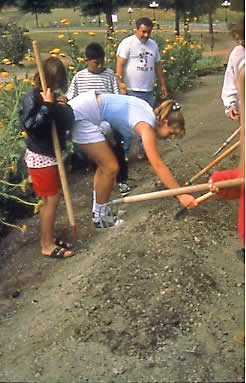|
Mounding Technique
Using stakes, twine and a tape measure mark the bed to the desired width or draw lines with gypsum. If using a tiller do this step after rototilling. Require anyone using power equipment to wear safety glasses and protective clothing to prevent possible injury.
Be sure you’re leaving adequate space for pathways. A 3-4 foot wide path will allow sufficient space for a gardener’s wheelbarrow, a child or teacher in a wheelchair as well as standing room for several children. A simple mounded bed will reach 4-6 inches high without side support. Mounded beds require more maintenance than enclosed beds and beds lose shape when little feet cut corners or hurdle plantings.
Use a digging fork to loosen the soil. Slide fork under the soil and lift without turning. Fork up the soil to loosen. Hill the beds to a height of four to six inches.
Work the soil thoroughly to a depth of 12-18 inches. Now is the time to spread and till in gypsum, compost, organic matter, pre-plant fertilizer, and the other soil amendments recommended from your soil analysis data. Use a shovel or rake to pull soil from the walkway to the top of the bed. Stand in one walkway and draw soil toward you from the opposite path. When you have completed one side, repeat the process from the other side. From this point on, walk only in those pathways, not on the marked beds.
 |
| Example of mounding |
|
